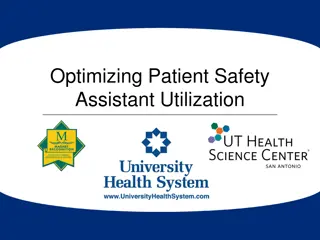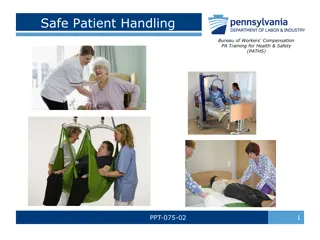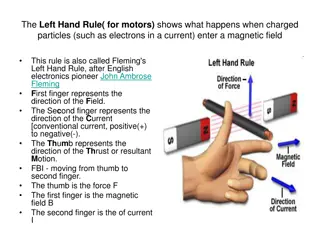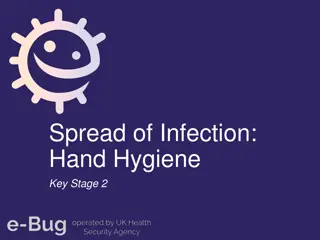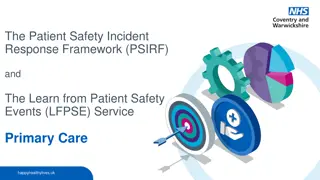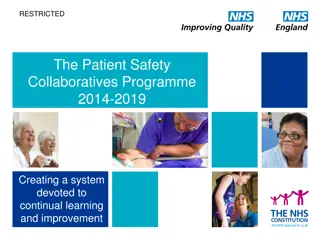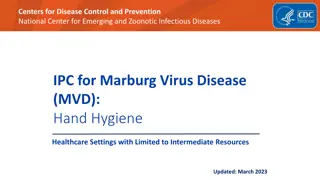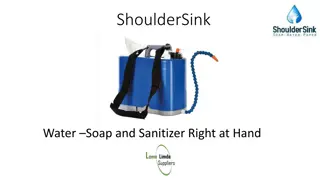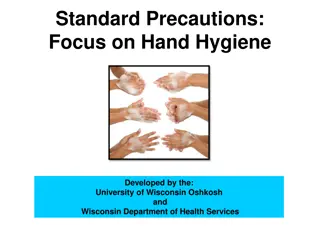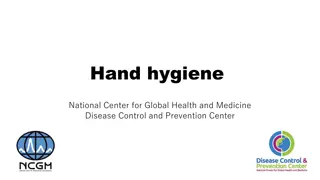Ensuring Patient Safety through Standardized Hand-Off Communications
Explore the significance of standardized hand-off processes in enhancing patient safety, as emphasized by the National Patient Safety Goals. Learn about the impact of medical errors, communication issues, and strategies for effective hand-offs. Discover how high reliability organization methodologies can be utilized to improve hand-off practices and reduce errors in healthcare settings.
Download Presentation

Please find below an Image/Link to download the presentation.
The content on the website is provided AS IS for your information and personal use only. It may not be sold, licensed, or shared on other websites without obtaining consent from the author. Download presentation by click this link. If you encounter any issues during the download, it is possible that the publisher has removed the file from their server.
E N D
Presentation Transcript
Standardizing Hand offs Standardizing Hand offs for for Patient Safety Patient Safety
Objectives Objectives Understand the background to National Patient Safety Goal 2E Discuss 3 methods of achieving effective Hand-offs State how strategies developed in high reliability organizations (HROs) can be applied to Hand-offs 2
Institute of Medicine Report Institute of Medicine Report Impact of Error: 44,000 98,000 annual deaths occur as a result of errors Medical errors lead followed by surgical mistakes and complications More Americans die from medical errors than from breast cancer, AIDS, or car accidents 7% of hospital patients experience a serious medication error Federal Action By 5 years: medical errors by 50%, nosocomial by 90%, and eliminate never- events (e.g., wrong- site surgery) 3
Institute of Medicine Report Institute of Medicine Report Cost associated with medical errors is Cost associated with medical errors is $8 $8 29 billion annually. 29 billion annually. 4
Communication Issues Leading Communication Issues Leading Factor in Root Causes Factor in Root Causes Targets for Teamwork Collation of sentinel event-related data reported to The Joint Commission (1995-2005). Available http://www.jointcommission.org/SentinelEvents/Statistics/ 5
Joint Commission Joint Commission National Patient Safety Goal National Patient Safety Goal- -2E 2E Implement a standardized approach to hand-off communications including an opportunity to ask and respond to questions. 6
Joint Commission Joint Commission National Patient Safety Goal National Patient Safety Goal- -2E Implementation Expectations: Implementation Expectations: 2E Interactive communications allowing the opportunity to ask or respond to questions Include up to day information regarding: Care Treatment Services Condition Recent or anticipated changes 7
Implementation Expectations (cont.): Implementation Expectations (cont.): Limited interruptions Sufficient time allocated Process for verification of the information Repeat back Read back Receiver reviews relevant historical patient data including: Previous care Previous treatment Previous services 8
Hand off Defined Hand off Defined The transfer of information (along with authority and responsibility) during transitions in care across the continuum for the purpose of ensuring the continuity and safety of the patient s care. 9
Types of Hand offs Types of Hand offs On call responsibilities Critical reports (laboratory and imaging ) Hospital transfers (home, skilled nursing facility) Other transitions in care (ED, radiology, physical therapy) 10
Types of Hand offs Types of Hand offs (cont.) (cont.) Patient hand-offs Level of care (cross coverage) Nursing shift change/break relief Physician transferring care OR to PACU 11
Are Surgical Patients at Risk? Are Surgical Patients at Risk? Procedure scheduled (clinician's office) Scheduling office Pre-procedure assessment Admitting department Pre operative area/nursing unit 12
Are Surgical Patients at Risk? Are Surgical Patients at Risk? Procedures invasive/noninvasive PACU Nursing unit Home Clinician s office for post procedure evaluation 13
Communication During Communication During Transitions in Health Care Transitions in Health Care Patient Safety Improve Continuity of Care by Improving Accuracy Structure 14
Hand off Concepts Hand off Concepts High Reliability Organizations Nuclear Power NASA and Mission Control Aviation: Crew Resource Management Air traffic control Carrier flight deck Dispatch services 15
Barriers to Effective Barriers to Effective Communication Communication Human fallibility Complex systems Limitations of learning & training Continuity gaps Negative impact of fatigue Time constraints Volume of information Confidentiality 16
MD MD RN Communications RN Communications Differences in: Style of communication Hierarchy is an issue Past experience Level of empowerment Tone of voice Level of respect 17
Recent Research Recent Research Evidence-based report Ineffective handovers can lead to: Wrong treatment, delay in Dx., severe adverse events, patient complaints Increase H/C costs, length of stay (and more) System Culture Individual Australian Council for Safety and Quality in Health Care. Clinical hand-over and Patient Safety Literature Review Report; March 2005. Available http://www.safetyandquality.org/clinhovrlitrev.pdf 18
Recent Research Recent Research How to Study Hard-to-see-things : Shift Change in the Emergency Department" Poorly studied, despite importance Shift change as a source of Failure Shift change as a source of Recovery Wears R, Roth E, Patterson E, Perry S. "Shift Change Signovers as a Double-Edged Sword: Technical Work Studies in Emergency Medicine". Society for Academic Emergency Medicine, Annual Meeting. New York, NY; May 25 2005. Available http://www.saem.org/meetings/05hand/wears.ppt 19
Recent Research Recent Research 12 Simulated Patients 5 consecutive handover cycles 3 different styles Verbal handover resulted in loss of all data Note taking style resulted in loss of 31% Form with verbal handover resulted in minimal loss Pothier, D, Monteiro, P, Mooktiar, M, Shaw, A Pilot study to show the loss of important data in nursing handover . British Journal of Nursing, 2005, vol14, No. 20. 20
Implementation Suggestions Implementation Suggestions Assess all points where hand offs occur Concurrently monitor process at all points Conduct gap analysis Identify champions, physicians, nurses, leadership 21
Implementation Suggestions Implementation Suggestions Select a consistent approach to hand offs Develop a policy and procedure Educate staff Implement the policy Monitor & report findings 22
Why Consistency is Needed Why Consistency is Needed Complicating factors inhibit consistency Differences in styles of communication Gender differences Cultural background Hierarchy of decision making Level of respect between physicians and nurses Level of empowerment 23
Consistency in Communication Consistency in Communication Focuses on the patient and individual needs Reduces impact of complicating factors Increases the odds of consistent quality & service to patient Requires physicians to become more intentional and disciplined in their interaction with employees Requires employees to become more disciplined in their work with physicians 24
Standardized Communication Standardized Communication Focuses on the patient not the people Standardized format allows all parties to have common expectations: What is going to be communicated How the communication is structured Required elements 25
Assertive Communication is: Assertive Communication is: Being organized in thought and communication Being competent technically and socially Disavowing perfection while looking for clarification/common understanding Owned by the entire team not just a subordinate skill set It must be valued by the receiver to be successful 26
Assertion Is Not Assertion Is Not Aggressive/hostile, Confrontational, Ambiguous, or Ridiculing 27
Why is Assertion So Hard? Why is Assertion So Hard? Hierarchy of decision making Lack of common mental model Don t want to look stupid Not sure I m right Culture Gender 28
Communication Check List Communication Check List Get the person s attention Make eye contact, face the person Use the person s name Express concern Use the communication technique (e.g., I-SBAR) Re-assert as necessary Decision reached Escalate if necessary 29
Sample Communication Tools Sample Communication Tools I-SBAR I PASS THE BATON 5 P s 30
I I - - SBAR SBAR I introduction S - ituation (the current issue) B - ackground (brief, related to the point) A - ssessment (what you found/think) R ecommendation/request (what you want next) 31
Introduction Introduction State your name and unit I am calling about (patient name) I 32
Situation Situation Patient age Gender Pre-op diagnosis Procedure Mental status pre-procedure Patient stable/unstable s 33
Background Background Pertinent medical history Allergies Sensory Impairment Family location Religion/culture Interpreter required Valuables deposition B 34
Background Intraop Background Intraop Meds given Blood given units available Skin integrity Musculoskeletal restrictions Tubes/drains/catheters Dressings/cast/splints Counts correct Other lab/path pending B 35
Assessment Assessment Vitals Isolation required Skin Risk factors Issues I am concerned about A 36
Recommendation/Request Recommendation/Request Specific care required immediately or soon Priority areas Pain control IV pump Family communication R 37
I PASS THE BATON I PASS THE BATON 38
I PASS THE BATON I PASS THE BATON I- Introduction: Introduce yourself P - Patient: Name: identifiers, age, sex location A - Assessment: The problem procedure etc. so far in the process S- Situation: Current status/Circumstances, uncertainty, recent changes S - Safety concerns: Critical lab values/reports; threats, pitfalls and alerts 39
I PASS THE BATON I PASS THE BATON B B- background: Co-morbidities, previous episodes, current meds, family A A- actions: What are the actions to be taken and brief rational T T- Timing: Level of urgency, explicit timing, prioritization of actions O O - Ownership: Who is responsible (person/team) including patient/family N N- Next: What happens next? Anticipated changes? Contingencies 40
Hand off: 5 Hand off: 5- -Ps Ps Ensures proper information is passed during patient transfers or provider shifts change. Use the 5 Ps: P Patient P Plan P Purpose P Problems P Precautions After instituting guidelines with the behavior-based expectations, Sentara Health experienced a 21% increase in effective handoffs. Gary Yates, Sentara Healthcare. Panel 1 Promising Quality Improvement Initiatives: Reports From the Field. AHRQ Summit Improving Health Care Quality for All Americans: Celebrating Success, Measuring Progress, Moving Forward ; 2004. 41
Issues, Dilemma Issues, Dilemma and and Tradeoffs Tradeoffs Ineffective methods: unstructured, one- way Time commitment and process changes required Extreme variability and uniqueness of hand offs and transitions Lack of focused research on healthcare hand offs Effectiveness 42
Spread of Hand Spread of Hand- -off Tools off Tools Other ideas: - 3 x 5 laminated pocket cards - Orientation of new staff (RN, MD, Residents) - Stickers on the phone - Screen savers - Nursingnewsletter Forms Check lists IT support Nursing Notes Post hospitalization and Primary Care Provider 43
Conclusions Conclusions Transitions in care are a prime target for improved patient safety efforts Sentinel event data creates urgency for change Strategies developed in high reliability organizations can be applied to health care The Joint Commission s National Patient Safety Goals have accelerated the pace of change in applying human factor science to patient care handoffs 44
Questions ? 45




